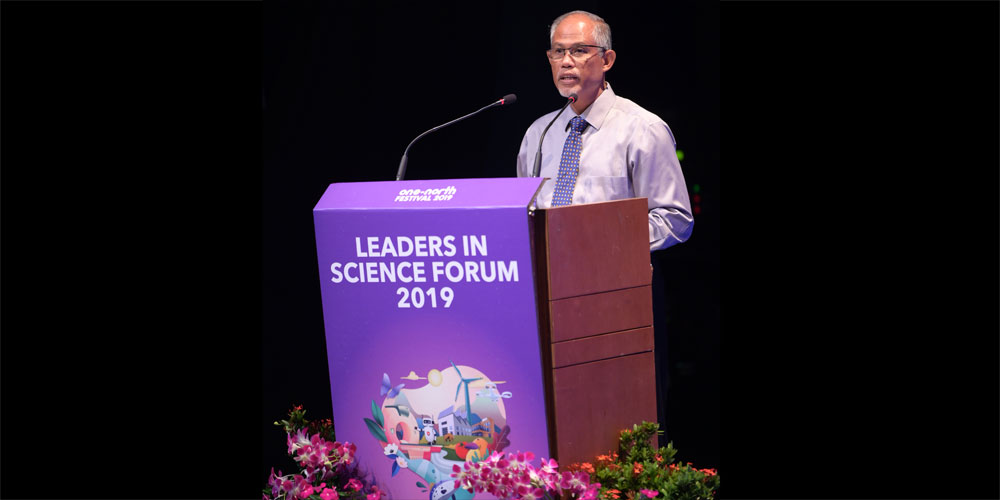INNOVATE
How science drives sustainability for the Future

Sustainability can no longer be viewed merely as a means for nations to provide a green and liveable environment. On the contrary, sustainability has taken on an existential significance.
Mr Masagos Zulkifli, Singapore’s Minister for the Environment and Water Resources (MEWR) in his opening speech at the Leaders in Science Forum 2019.
Organised by the Agency for Science, Technology and Research (A*STAR), JTC Corporation and National Research Foundation (NRF), the forum kicked off the week-long one-north Festival celebrating research, science and innovation. Speakers from a broad range of disciplines – from history to sociology and science – tackled the issue of innovating for a sustainable future.
Guest-of-honour, Mr Masagos pointed out that the multi-faceted challenges of climate crisis meant that we have to “rethink our assumptions, break the mould and find new pathways towards a sustainable future”. He said that he viewed science and technology – from wide-ranging domains such as biological and engineering sciences to human psychology and behavioural science – as a key sustainability enabler.
Is sustainability still an abstract concept?
Singapore has been moving towards a more sustainable economy where resources are recycled and reused. Although water recycling is an oft-cited example, the recent Resource Sustainability Act passed in Parliament will encourage firms to reuse and recycle food, electronic and packaging waste.
The lively panel discussion at the Leaders in Science Forum 2019 saw the sustainability challenge tackled from different perspectives.
Professor Paulin Tay Straughan, Professor of Sociology and Dean of Students for the Singapore Management University, pointed out that recycling was a difficult concept to grasp as the benefit of new technologies may not be seen. She commented that “The sense of stakeholder ownership needs to be stronger when we’re targeting something that we cannot see.”
Professor Ng Wun Jern, President’s Chair in Civil and Environmental Engineering for the Nanyang Technological University concurred. He said that science might have afforded us the understanding but not necessarily the solution. The historical, social, cultural, religious and business aspects were just as important for a successful solution.
One solution may be in urban farming. As cities evolve and become more detached with how food is grown, ComCrop (co-founded by Mr Allan Lim) seeks to build that connection with an 8000-square feet rooftop farm. His vision is that this farm would not only reduce the time from farm to table for a perishable product but also provide employment opportunities for the marginalised workforce, such as part-timers or those with special needs.
“Including the younger generation is also critical as they are hopeful and optimistic about the world they are creating”, said Dr Mayor, adding that Singapore’s successful NeWater programme was a case in point.
Professor Ng lauded the fact that there was a lot of emphasis on educating the young, visualising the process and backing that up with scientific facts. He highlighted that having been educated on NeWater, the younger generation, now adults, were made more conscious of the need to conserve water.
Making Singapore Cool(er)
Professor Gerhard Schmitt, Director of the Singapore-ETH Centre noted that Singapore’s geographical location on the equator meant global warming would have direct impact on the island.
The Urban Heat Island Effect (UHI) brought about by dense urban infrastructure, heat-trapping buildings, reduced vegetation and human activities have increased temperature on the island five to seven degrees above where it should be.
Professor Schmitt is the lead principal investigator of the Cooling Singapore project, funded by the NRF to tackle the issue of increasing temperatures on the island with climate-responsive design guidelines and masterplan.
“Climate-responsive urban planning to improve walkability and public transport systems will help to reduce the amount of heat transmitted from private vehicles”, he said.
A New Urban Planning Tool for a New Urban Cool
Devised by A*STAR's Institute of High Performance (IHPC), Institute for Infocomm Research (I2R) and the Housing & Development Board (HDB), the Integrated Environmental Modeller (IEM) is the advanced modelling tool that leverage on virtual “Digital Twin” platform which allows for efficient refinement to urban plans. The IEM uses high-resolution 3D city models to simulate the interaction of environmental conditions such as solar, wind, temperature and noise with the urban landscape.
The tool helps to guide urban designers in designing buildings that harness wind flow and have a reduced solar irradiance. It not only reduces the risk of costly physical trial-and-error but also provides quantitative and scientific assessments for the environmental performance of the building, allowing urban planners to understand the different trade-offs involved in the planning process.
Housing and Development Board (HDB) used A*STAR IHPC’s IEM in the planning of Tengah town. Currently, the scaled-up IEM allows users to perform simulations for the whole of Singapore and potentially study microclimate at city-scale.
What is the endgame on sustainability?
The panellists agreed on one thing – the need to know the endgame. The community needs to understand the effect of climate change on everyday life for there to be real change.Science affords us an understanding, but it does not necessarily give us the solution. There is a need to carry the science through to technology development, engineering and then deployment. We have to be cognisant that culture, history and the social aspects will come to play.
In the words of Professor Ng.
Encouraging industries to normalise new technologies and practices and take a whole-country approach, may help bring a greater sense of urgency to sustainable practices.
Was the article helpful?
A*STAR celebrates International Women's Day

From groundbreaking discoveries to cutting-edge research, our researchers are empowering the next generation of female science, technology, engineering and mathematics (STEM) leaders.
Get inspired by our #WomeninSTEM
